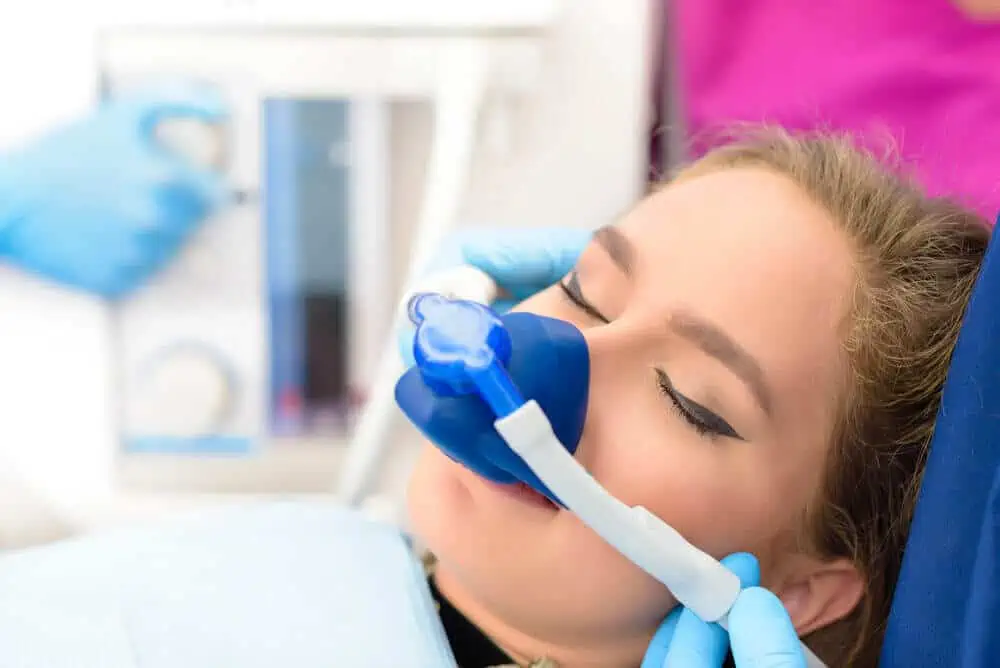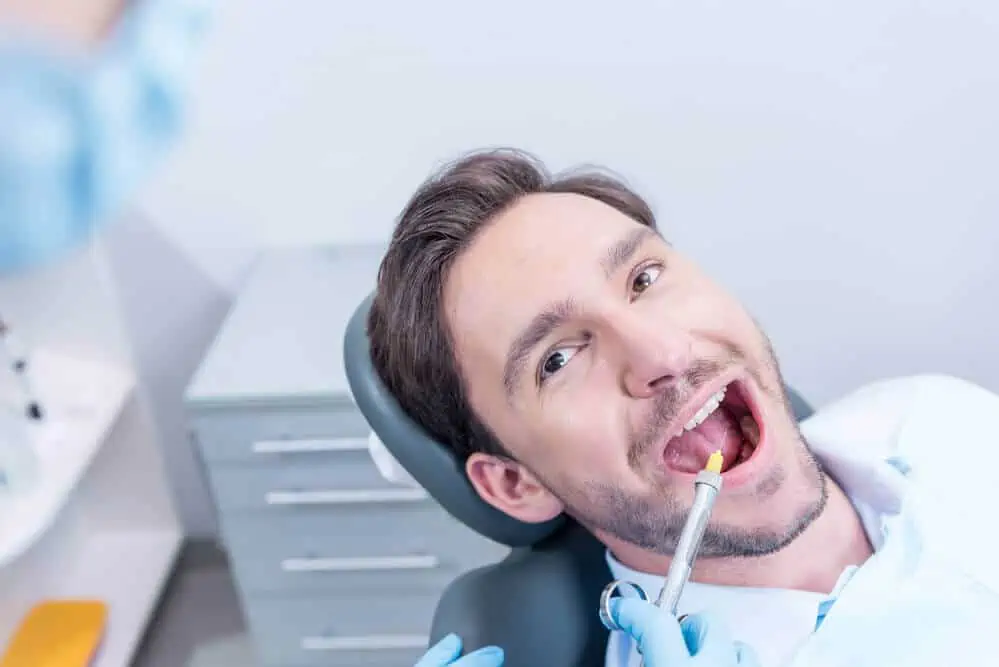With sedation dentistry becoming more popular over the past few years, it has become easier for people to overcome dental anxiety and receive stress-free treatment for their dental problems. But what exactly does dental sedation dentistry involve?
In this article, we will explain:
- What is sedation dentistry and what are the different types of sedation?
- How does the process of dental sedation work?
- How much does dental sedation cost in the UK? Private and NHS
- How to find a sedation dentist near you
- Is sedation dentistry safe?
We hope this information helps you better understand your dental sedation options and their costs, allowing you to ultimately receive the treatment you need.
Save the trip to your NHS dentist and speak to a certified dentist right now online. Visit JustAnswer to chat online with a qualified dentist and find out all the information you need – without having to take time out for a dental appointment.
Their dentists are based in the US and are available 24/7 to help you out!
What is sedation dentistry?
Sedation dentistry is used by dentists and anesthesiologists to calm or make patients more comfortable before and during dental work.

It includes a variety of sedation options for patients with dental anxiety. Some simply make you feel more relaxed, while others put you into a sleepy state and you won’t remember much about your treatment.
How does sedation dentistry work?
Each method of dental sedation has its own purpose and strength. Your dentist will choose the most appropriate sedation and protocol for your situation. This will be based on certain factors such as:
- Intensity of the dental procedure being performed
- The duration of the dental procedure
- Your level of dental anxiety
A dentist may choose any one of the following forms of sedation:
- Minimal sedation: Patients are awake but in a calm and relaxed state
- Moderate sedation: Patients are conscious, but may experience slurring of speech and slight memory loss
- Deep sedation: Patients are near unconsciousness, but still able to communicate
- General anaesthesia: Patients are completely unconscious and unaware of the procedure
A standard anaesthetic is used alongside all types of conscious sedation to numb the mouth and guarantee a pain-free procedure.
Types of dental sedation
Before performing a procedure, the sedation dentist has to choose the appropriate type of dental anaesthesia for the patient. While some of these sedatives can make patients completely unconscious, others like oral sedation simply relax them.
The most common types of sedatives used for dental procedures are:
Inhalation sedation (gas and air)
This method involves the patient inhaling nitrous oxide through a nosepiece to relax or calm them. The effects of nitrous oxide wear off quickly, so you may be able to return to your regular schedule after leaving the dentist’s office.

Oral sedation
Oral sedation is the use of medicines that can be taken via the mouth, either as a tablet or a liquid. It takes about 10 minutes to start working, but you might be asked to take the medicine up to an hour before your appointment.
Oral sedatives are a form of conscious sedation. They make patients feel calm and relaxed, and perhaps a bit sleepy, but still able to communicate with the dentist throughout.
Intravenous sedation
Intravenous or IV sedation is an important component of sleep dentistry and uses anaesthesia that can put patients into varying stages of consciousness. It’s also sometimes called ‘twilight anaesthesia’ or ‘conscious sedation’. Although you are still awake and able to communicate, the sedation will make you feel very sleepy. Additionally, it prevents your brain from forming new memories, so once the procedure is over, you won’t remember anything.
The dentistry team will closely monitor your vital signs, since the sedation can slow down your breathing, and will administer extra oxygen if needed.
To see more about how IV sedation dentistry is performed and how it helps dentists and patients, feel free to watch the video below.
IV sedation dentistry also extends to general anaesthesia, which induces a deep sleep until the effects wear off. This is generally only used for extensive dental procedures such as complicated or multiple extractions (especially in young children) and also some dental surgeries.
How long does dental sedation last?
The amount of time it takes for the effects of a dental sedative to wear off depends on the form of sedation, dosage, duration of treatment and the ability of the body to recover. The clinician carefully plans and administers the right amount of sedative for your situation.
While nitrous oxide wears off minutes after inhalation stops, oral and IV sedation take at least 1-2 hours or more to wear off.
How does the process of dental sedation work?
Dental anxiety can affect different people in many different ways. For some, just stepping into the dentist’s waiting room can cause nervousness, while others may dread the potential pain of a procedure. Certain procedures, such as removing wisdom teeth, can be especially uncomfortable, leading many patients to choose dental sedation.
If you are undergoing sedation for a tooth extraction or any other treatment, here’s what you can expect:
Before sedation
As part of your first appointment, the dentist will discuss your treatment course as well as sedation options with you. You will most probably be asked to sign a consent form to show that you have agreed to the treatment.
Depending on the form of sedation chosen, you may be required to fast for several hours before treatment, or be advised to eat a light meal about an hour before your appointment. Make sure to fully discuss the process with your dentist and get answers to all the questions you may have.
Having oral or intravenous sedation also requires someone to accompany you to the clinic and ensure that you return home safely, since you will feel drowsy for a while afterwards.
If you have extremely high levels of anxiety about the appointment, your dentist may give you an oral sedative to take before you arrive at the clinic.
During sedation

As soon as the dentist administers the sedative, it will enter your bloodstream and make you feel relaxed, calm, and slightly lightheaded. Your arms and legs may feel heavier than normal, and you might feel a bit sleepy if you are receiving oral or intravenous sedation.
Your dentist will then administer an anaesthetic to the area of your mouth being treated. They can use a numbing gel to keep discomfort to an absolute minimum as they do this. Within a minute, the anaesthetic will have taken effect and the dentist can begin the procedure without you experiencing any pain.
Smoking marijuana before getting sedation can cause complications during the procedure due to airway blockage. If you are a regular marijuana user, you must notify your dentist or oral surgeon before your surgery.
That’s because marijuana users may require as much as three times more sedation medication to achieve the same type of anaesthesia as non-marijuana users.
Your dentist won’t judge you, but they do need to know so they can ensure your safety and comfort during the procedure.
Dr. Eric Scharf – 7×7 Dental Implant & Oral Surgery Specialists
After sedation
The recovery process depends on the type of sedation that you received. Read below to find out more about the recovery process after receiving inhalation sedation or oral/intravenous sedation.
After inhalation sedation
The effects of inhalation sedation wear off within a few minutes and you can go about your day as normal. Just take note that your mouth will feel a bit numb for about 30 minutes afterwards.
After oral or intravenous sedation
When undergoing oral or IV sedation, you will need to remain at the clinic after treatment while a clinician monitors your recovery. It can take up to 12 hours for the sedative to fully wear off, and it’s normal to feel drowsy and lightheaded during this time. You should therefore make sure that you have someone to accompany you home and, if possible, stay with you until you feel back to normal.
If you have any children, it is advisable to arrange childcare for the day of your appointment.
The sedative can affect your reflexes, coordination and judgement until the following day. It’s advisable not to do any of the following until the next day after your dental treatment:
- Drive any vehicle or ride a bicycle
- Exercise
- Return to work
- Drink alcohol
- Smoke or use any kind of nicotine products
- Take sleeping tablets
- Use any machinery, home appliances, or sharp utensils
- Cook or heat anything in the kitchen, including water for a cup of tea or coffee
- Make important decisions including financial transactions
This NHS sedation dentistry video summarises what the procedure will involve for you and your accompanying person:
How much does dental sedation cost in the UK?
Dental sedation is available both privately and on the NHS in the UK. Read below to find out about the respective costs involved.
Private dental sedation cost
Private dental sedation costs vary according to the method used and the treatment duration. Dentists either apply a charge per 30-minute session or per hour. The table below summarises the approximate charges you can expect for private sedation dentistry. (Note that these are sedation costs only and regular treatment fees still apply.)
Type of sedation | Approximate cost |
Inhalation | £50 - £200 |
Oral | £100 - £250 |
Intravenous | £150 - £500 |
NHS sedation dentist cost
The cost of sedation dentistry on the NHS can also vary. You may find that the cost of sedation is included in the standard NHS dental treatment fee, or an extra charge may be applied. Note that if you are referred to a different dentist for treatment with sedation, this will usually count as a separate course of treatment. This means you will have to pay for a checkup at your original dentist as well as for the treatment at the sedation dentist.
How do I find a sedation dentist near me?
Since not all dentists offer every type of sedation, it may be necessary for you to do some research to find a sedation dentist. Here are some ways you can find a suitable clinic:
- Ask friends and family for recommendations
- Search online for dentists near you who specialise in sedation dentistry
- Ask your regular dentist to refer you to a nearby sedation dentist
If you’re unsure about booking an appointment, we recommend first visiting the clinic to find out more. During your dentist appointment, open up about your dental anxieties so that your treatment can be planned accordingly. Your first appointment will be a general checkup, where they examine your mouth and take an x-ray if needed. From there, the dentist will discuss your treatment course and your options for conscious sedation.
Finding an NHS sedation dentist near you
The first step to finding an NHS sedation dentist near you is to visit your usual NHS dentist. If they do not offer sedation dentistry, they will be able to refer you to a nearby NHS sedation clinic. It is important to note that you cannot visit a specialist clinic without a referral.
If you aren’t yet registered with an NHS dentist, click here to find your nearest one!
Is dental sedation safe?

Feeling nervous about your dental treatment and dental sedation is completely normal. Fortunately, there are minimal risks involved with the dental sedation methods described in this article. Additionally, your dentist will take several precautions to keep you safe during sedation.
You may be advised to stop taking certain chronic medications leading up to your treatment. Your dentist will discuss all of these precautions with you. You will be closely monitored during your sedation in case your breathing slows and you need to be administered oxygen.
Dental sedation is not safe for pregnant women, and breastfeeding should be avoided for 12 hours after sedation.
Side effects of dental sedation
After intravenous or oral sedation, it’s normal to feel drowsy and lightheaded for most of the day. You may also experience some bruising in your arm or hand from the injection, but this should disappear within a few days.
The risk of other sedation side effects is very low. In some rare cases, patients experience an allergic reaction or vomiting. For this reason, it is important to communicate with your dentist about any medical allergies you may have. Your dentist will explain the risks involved and answer any questions you have before proceeding with any kind of sedation dentistry.
Conclusion
If you are particularly worried about an upcoming dental procedure, or visiting the dentist in general, sedation dentistry can help you overcome this anxiety. Sedation dentistry is available in the UK on both the NHS and with a private dentist.
There are several different types of dental sedation, namely inhalation, oral, intravenous (IV) and general anaesthesia. Your dentist will choose the most appropriate form of sedation for you depending on the type of dental procedure, duration of the procedure and your level of anxiety.
If you are undergoing oral or intravenous sedation, you’ll need to prepare for the procedure by making sure you have someone to accompany you to the clinic and during recovery. Some forms of sedation will require you to fast for a certain period of time before the procedure, or to stop taking certain chronic medications. Your dentist will communicate all necessary details with you during your pre-procedure appointment.
Dental sedation will make you feel calmer and will help you relax during your treatment. You might not remember much of it at all, and the idea of returning to the dentist will eventually feel less daunting. You’ll also probably feel a great sense of relief at having finally got the dental treatment you have been waiting for!
And remember, you can chat with a dentist at any time — 24/7 about your temporary crowns. A team of certified dentists is standing by at JustAnswer.
FAQs
How much does dental sedation cost in the UK?
The cost of dental sedation varies on both the NHS and with private dentists. With a private dentist, you can expect to pay anywhere from £50-£500 depending on the type of sedation. The cheapest method is inhalation sedation, while intravenous sedation is the most expensive.
You may find that the cost of dental sedation is included in the standard NHS dental treatment fee, or an extra charge may be applied if you have to be referred to a separate NHS sedation dentist.
How do I find an NHS sedation dentist near me?
The first step to finding an NHS sedation dentist near you is to visit your usual NHS dentist. If they do not offer sedation dentistry, they will be able to refer you to a nearby NHS sedation clinic. It is important to note that you cannot visit a specialist clinic without a referral.
Will I feel anything during the treatment after dental sedation?
In most cases, patients do not feel a thing. Some may feel slight discomfort, but at the end of the appointment, most are relaxed with no memory of the procedure.
Am I a good candidate for sedation dentistry?
Any of the following may make you a good candidate for dental sedation:
- Anxiety of visiting a dentist
- Fear of shots or needles
- History of a traumatic dental experience
- Inability to handle noises or smells in a dentist’s office
- Having sensitive teeth
- Need of a complex treatment
In addition, patients with special needs might benefit from dental sedation.
Is sedation dentistry safe for children?
Yes, paediatric sedation dentistry is just as safe as adult sedation dentistry. It is routinely performed in multiple clinical settings, so there is no need to worry.
Anesthesia progress: Nitrous oxide and the inhalation anesthetics. Consulted 8th April 2020.
NCBI: Conscious Sedation in Dentistry. Consulted 8th April 2020.
Royal College of Surgeons: Standards for Conscious Sedation in the Provision of Dental Care. Consulted 8th April 2020.




